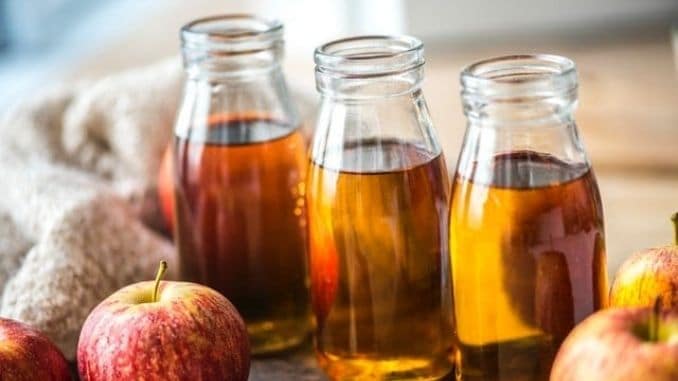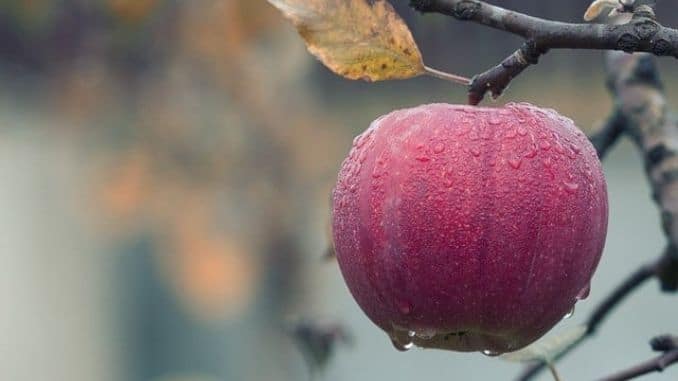If you think you’re hearing more about apple cider vinegar these days, you’re probably right.
A survey by The Vinegar Institute revealed that consumers are using vinegar for a variety of tasks, mostly for cooking and cleaning, but also for removing laundry stains, polishing metal, softening dry skin and treating bee stings. Others turn to vinegar for health wellness purposes, or even for freshening the air.
Another survey of more than 11,000 people by ConsumerLab.com also showed apple cider vinegar, in particular, gained considerable popularity in recent years. Health endorsements from celebrities like Dr. Mehmet Oz and Katy Perry have contributed to its popularity.
So, what is all the hype about? What is apple cider vinegar anyway?
A Little History of Vinegar
Referred to as ‘sour wine’ or ‘sour liquid,’ vinegar has stood the test of time, serving diverse purposes for millennia. Discover its enduring legacy and timeless versatility. The story goes that it was first discovered accidentally thousands of years ago when someone left the wine to ferment for too long, and it turned acidic.
Babylonian scrolls revealed that as far back as 5000 B.C., vinegar was used as a condiment and food preservative. Residues were found in Egyptian urns dating back to 3000 B.C. Ancient Chinese texts dating also talk about vinegar and, in about 400 B.C., the Greek “Father of Medicine,” Hippocrates, was known to use it to help heal his patients’ wounds and respiratory diseases.
Julius Caesar’s armies drank vinegar as a tonic to ward off disease, and legend says that Cleopatra used it to create a love potion for Marc Antony. Romans quenched their thirst with “posca,” a potent blend of water and vinegar sold on bustling streets, revered for its purported ability to invigorate and fortify strength. They also soaked small pieces of bread in vinegar during meals.
Romans, true innovators, harnessed vinegar’s versatility—crafting salads, marinating meat and fish, purifying the body, and even tending to minor wounds. A testament to vinegar’s timeless utility!
When the Middle Ages came around, vinegar was a popular option as a tasty condiment, disease preventative, antimicrobial cleanser and infection preventative. Vinegar continued to be the preferred choice for doctors in several European countries as they all washed their hands with it before and after visiting ill people and recommended everyone use it during the cholera outbreak of the 1800s.
Gradually, people started using vinegar for a variety of other uses as well, including in aromatherapy and to prepare mouthwashes, ointments, massage oils, foot baths and more. In the 1900s, as manufacturers turned to more modern ingredients to develop products, vinegar took a back seat.
With today’s desire for more natural solutions, however, it’s no surprise that it’s experiencing a resurgence in popularity.
Where Does Apple Cider Vinegar Come From?
Any fermentable carbohydrate source, be it fruit, wine, beer, dates, grains, or potatoes, can be used to produce vinegar. With apple cider vinegar, the source is apples. In fact, you can make your own apple cider vinegar at home if you want to. However, be prepared as it takes a great deal of time.
Start by filling a sterilized quart jar with clean apple peels, cores, apple scraps or slices of apples. Sterilization is important to avoid introducing bacteria. You can use any variety of apples you like or even a combination of different kinds.
Mix about a quarter-cup of sugar to one cup or more of water, and pour over the apple scraps, making sure to cover them all. The sugar helps speed up the fermentation process. You can also use honey, but it may not work as well.
Cover the jar with a muslin cloth or a coffee filter so it can “breathe,” and secure it with a rubber band or canning jar ring. Place in a warm, dark place. Leave it for a few days until the mixture starts to foam and bubble. That’s a sign that the fermentation process is proceeding.
About two or three weeks later, you’ll be able to strain out the scraps and then pour the liquid back into the jar. Cover again as you did before and store in a cupboard or pantry for another 4-6 weeks. Stir every few days.
In the second phase of the process, sugar alcohols undergo conversion into vinegar. This occurs because bacteria called “acetobacter” begin to form. These bacteria create acetic acid, which is responsible for vinegar’s tanginess.
After another few weeks, the mixture should appear cloudy with a film on the surface. At this point, the vinegar is called the “mother,” as it can be used to start other batches of apple cider vinegar. It’s also referred to as “unfiltered” or “raw” apple cider vinegar. The filtered varieties have a clear, amber-colored appearance because all of the raw ingredients have been filtered out.
The mother vinegar has a murky appearance and contains all the acetic acid bacteria along with enzymes and the other nutrients. Some believe it works better than filtered varieties for health and wellness purposes. It also has a more complex flavor and is less processed.
After six weeks, the fermentation process concludes, and your homemade apple cider vinegar is ready for use. You can test it by taste. For a mild vinegar, it takes less time. If you like it stronger, let it sit a bit longer.
After completion, filter out additional ingredients based on preference, then cover the jar with a lid and store until needed. If you keep at least some of the “mother” form, you can use it when you’re ready to make another batch of vinegar. Add it to your apple scraps and start the process over.
Although this is the basic, homemade way to create apple cider vinegar, it’s important to realize that today’s manufacturers often add ingredients to speed up the process and to make it work better on a large scale.
They may add yeast to help promote fermentation, for example, or add bacteria to more quickly convert the sugar alcohols to acetic acid. Manufacturers often filter various apple cider vinegar types to eliminate “mother” ingredients and apply pasteurization by heating the product.
How Does Apple Cider Vinegar Work?
It’s the unique nutrients in the apple cider vinegar that make it effective for so many things. These include:
- Pectin
- B vitamins
- Vitamin C
- Small amounts of minerals, such as sodium, phosphorous, potassium, calcium, iron, and magnesium
- Beneficial enzymes
- Beneficial bacteria (probiotics)
- Acetic acid
- Citric acid
Besides water, acetic acid is the main ingredient in vinegar. Although scientists aren’t sure yet all the ways that acetic acid may work to create health benefits, they think that it can increase absorption of nutrients from the foods you eat and may help slow the breakdown of carbohydrates, preventing blood sugar spikes.
In fact, apple cider vinegar’s benefits for diabetics are pretty impressive. Numerous studies have indicated that it can positively affect insulin sensitivity and blood sugar levels in patients with type 2 diabetes — so many that scientists call apple cider vinegar an “anti-glycemic” agent, which means that it helps lower blood sugar.
Other studies have shown that adding vinegar to foods reduces their glycemic index, or their ability to raise blood sugar levels. When insulin-resistant subjects consumed a vinegar test drink (diluted vinegar) before a meal, their insulin sensitivity improved by 34 percent.
Even in healthy people, vinegar can help to keep blood sugar levels stable. In one study, subjects ate white bread alone or with vinegar. Those who consumed vinegar experienced a significant reduction in blood sugar levels approximately 30 minutes after the meal, compared to those who did not.
Some animal studies have also suggested that acetic acid can prevent fat deposition and improve metabolism too. Scientists aren’t sure how yet, but there is evidence indicating that acetic acid (or vinegar) may be helpful to those trying to lose weight.
The acid in apple cider vinegar is also what makes it a gentle cleanser. It can break down dirt and grime and dissolve soap scum. Although white vinegar is a better option for tough jobs and laundry stains ― it is the most acidic and will not leave unwanted color behind ― apple cider vinegar works better for items that need a gentler touch.
Apple cider vinegar also has malic acid from apples, which gives it a different flavor and helps tame the harsh acetic acid. If you use the “mother” apple cider vinegar, you may also get the benefits of some of the other ingredients, including pectin which is a type of fiber that encourages healthy digestion and feeds the good bacteria in the gut. Those good bacteria are called “probiotics,” and pectin is a “prebiotic,” meaning it supports the health of the probiotics.
Because apple cider vinegar is acidic, it’s not wise never to consume it straight. Always dilute it with water or juice before drinking it.
What to Look for When Buying Apple Cider Vinegar
To find the apple cider vinegar that’s best for you, follow these tips:
If you want the added nutrients in the “mother” variety, look for the cloudy, “ugly” bottles. Clear vinegar is refined and more highly processed — it may even be artificially flavored.
Avoid plastic bottles. The acid in the vinegar can break down the chemicals in the plastics, increasing your risk of ingesting them. Look for glass bottles instead.
Find that certification. If you want organic vinegar, look for the United States Department of Agriculture label certifying that it’s organic. This may also help you avoid pesticides as organic products typically have products where fewer pesticides — if any — were used than conventional ones.
If you see the word “raw” on your vinegar, that means it hasn’t gone through filtration, pasteurization or any other chemical processes. It’s usually considered better for health purposes but be sure to buy from a trusted source to avoid contamination.
Check where it was made. If it’s a place where apples are traditionally grown, that’s a good sign.
Check the expiration date. Older varieties won’t have as many healthy, active ingredients in them as newer ones.
Digestive problems are incredibly common, but there are things you can do to improve your condition. Make sure to check out our 14-Day Digestive Health Quick Start Program, here!





